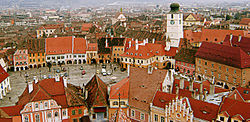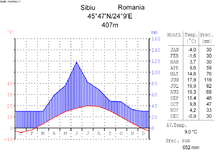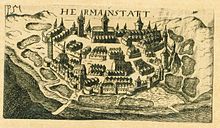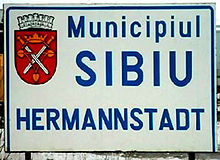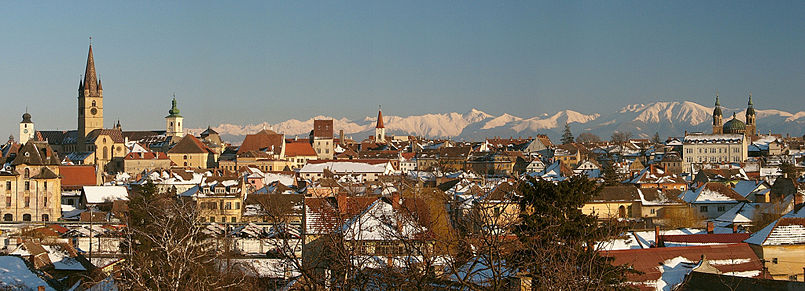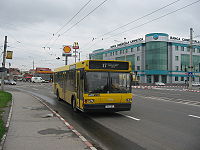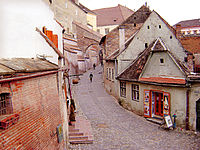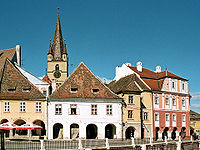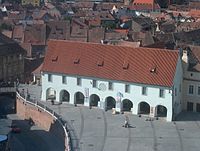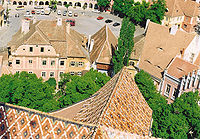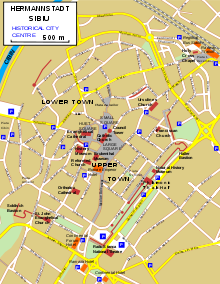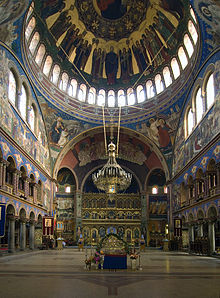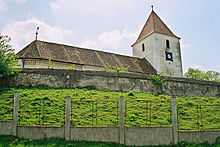- Sibiu
-
Sibiu — City — 
Coat of armsLocation of Sibiu within Romania (in red) Coordinates: 45°47′45″N 24°09′08″E / 45.79583°N 24.15222°E Country Romania Sibiu County Municipality of Sibiu Founded 1191 (first official record) Government – Mayor Klaus Johannis (Democratic Forum of Germans) Area – Total 121 km2 (46.7 sq mi) Elevation 190 - 240 m (-597 ft) Population (est. January 1, 2009[1]) – Total 154,548 – Density 1,273/km2 (3,297.1/sq mi) Time zone EET (UTC+2) – Summer (DST) EEST (UTC+3) Postal Code 55xxxx Area code(s) +40 269 Car Plates SB Website www.sibiu.ro Sibiu (Romanian pronunciation: [siˈbiw], antiquated, Sibiiu; German: Hermannstadt, Hungarian: Nagyszeben) is a city in Transylvania, Romania with a population of 154,548.[1] Located some 282 km north-west of Bucharest, the city straddles the Cibin River, a tributary of the river Olt. Nowadays the capital of Sibiu County, between 1692 and 1791 Sibiu was the capital of the Principality of Transylvania.
Sibiu is one of the most important cultural centres of Romania and, in tandem with Luxembourg, it was designated a European Capital of Culture for the year 2007. Formerly the centre of the Transylvanian Saxons, the old city of Sibiu was ranked as "Europe's 8th most idyllic place to live" by Forbes.[2]
The city administers the ski resort Păltiniş.
Contents
Geography and climate
Sibiu is situated near the geographical center of Romania at 45°47′34″N 24°09′07″E / 45.792784°N 24.152069°ECoordinates: 45°47′34″N 24°09′07″E / 45.792784°N 24.152069°E. Set in the Cibin Depression, the city is about 20 km from the Făgăraş Mountains, 12 km from the Cibin Mountains, and about 15 km from the Lotrului Mountains, which border the depression in its southwestern section. The northern and eastern limits of Sibiu are formed by the Târnavelor Plateau, which descends to the Cibin Valley through Guşteriţei Hill.
The Cibin river as well as some smaller streams runs through Sibiu. The geographical position of Sibiu makes it one of the most important transportation hubs in Romania with important roads and railway lines passing through it.
File:Winter sibiu balcescu 2007.jpgChristmas Sibiu 2007, snow and lightsSibiu's climate is temperate-continental with average temperatures of 8 to 9°C. The multi-annual average of rainfall is 662 l/mp, and there are about 120 days of hard frost annually.
City districts
The following districts are part of Sibiu. Some were villages annexed by the city but most were built as the city developed and increased its surface.
- Centru (Centre)
- Lupeni
- Trei Stejari (Three Oaks)
- Vasile Aaron
- Hipodrom I, II, III, IV
- Valea Aurie (Golden Valley)
- Tilişca
- Ştrand
- Ştrand 2
Two main industrial areas are located within the city limits:
- East industrial zone, alongside the railway to Braşov and Râmnicu Vâlcea
- West industrial zone, near the exit to Sebeş, close to the Airport
The Southern part, including the ASTRA National Museum Complex and the zoo, also falls within the city limits.
Geographic location

Sebeş Mediaş
Ocna SibiuluiAgnita 
Sălişte 
Avrig  Sibiu
Sibiu 

Răşinari Cisnădie Tălmaciu History
The first official record referring to the Sibiu area comes from 1191, when Pope Celestine III confirmed the existence of the free prepositure of the German settlers in Transylvania, the prepositure having its headquarters in Sibiu, named Cibinium at that time.[3] It was probably built near a Roman settlement, one that would be known during the early Middle Ages as Caedonia.
In the 14th century, it was already an important trade center. In 1376, the craftsmen were divided in 19 guilds. Sibiu became the most important ethnic German city among the seven cities that gave Transylvania its German name Siebenbürgen (literally seven cities), and it was home to the Universitas Saxorum, the assembly of Germans in Transylvania. Common opinion in the 17th century ascribed Sibiu the quality of being the easternmost city to be part of the European sphere;[citation needed] it was also the eastern terminus of postal routes.
During the 18th and 19th centuries, the city became the second and later the first most important center of Transylvanian Romanian ethnics. The first Romanian-owned bank had its headquarters here (The Albina Bank), as did the ASTRA (Transylvanian Association for Romanian Literature and Romanian's People Culture). After the Romanian Orthodox Church was granted status in the Habsburg Empire from the 1860s onwards, Sibiu became the Metropolitan seat, and the city is still regarded as the third most important center of the Romanian Orthodox Church. Between the Hungarian Revolution of 1848 and 1867 (the year of the Ausgleich), Sibiu was the meeting-place of the Transylvanian Diet, which had taken its most representative form after the Empire agreed to extend voting rights in the region.
After World War I, when Austria-Hungary was dissolved, Sibiu became part of Romania; the majority of its population was still ethnic German (until 1941) and counted a large Romanian community, as well as a small Hungarian one. Starting from the 1950s and until after 1990, most of the city's ethnic Germans emigrated to Germany. Among the roughly 2,000 who have remained is Klaus Johannis, who is currently[update] mayor of Sibiu City.
The city features in the famous novel "The Reader" (Der Vorleser) by German law professor and judge Bernhard Schlink, upon which an Oscar-winning film was based.
Milestones in Sibiu's history
- 1191 - Mentioned for the first time in a document of the Vatican, under the name "Cibinium" (due to the river Cibin that flows through the city)
- 1241 - Mongol victory over the Hungarian army, April 10
- 1292 - The first hospital in the Kingdom of Hungary was opened.
- 1380 - The first documented school in the Kingdom of Hungary.
- 1494 - The first pharmacy in the Kingdom of Hungary.
- 1534 - The first paper mill in the Kingdom of Hungary.
- 1544 - The first book in the Romanian language was printed in Sibiu, funded by John II Sigismund Zápolya. This was in Cyrillic letters.
- 1551 - Conrad Haas's experiment with rockets.
- 1570 - The Ottoman-dependent Principality of Transylvania was formed after the Ottoman conquest in Hungary.
- 1671 - Methane gas was discovered near Sibiu.
- 1782 - Franz-Joseph Müller von Reichenstein discovered the chemical element tellurium.[4][5]
- 1788 - First theatre in Transylvania.
- 1795 - The first lightning rod in Transylvania and in Southeastern Europe was installed in Nagydisznód (present-day Cisnădie).
- 1817 - The Brukenthal Museum, the first museum in Transylvania was opened.
- 1867 - The Principality of Transylvania was reunited with Hungary in the dual monarchy of Austria-Hungary
- 1896 - The first use of electricity in Austria-Hungary, and the first power line in Southeastern Europe.
- 1904 - The second city in Europe to use an electric-powered trolley.
- 1918 - Upon the Union of Transylvania with Romania, Sibiu became part of Romania.
- 1928 - The first zoo in Romania.
- 1941 - Saxons lost their historical majority in the population
- 1989 - The third city to take part in the Romanian Revolution.
- 2007 - European Capital of Culture 2007
Demographics
According to the last census, from 2002, there were 154,892 people[6] living within the city of Sibiu, making it the 15th largest city in Romania. The ethnic breakdown is as follows:
- Romanians 95.7%
- Hungarians 2%
- Germans (Transylvanian Saxons) 1.6%
- Other 0.7%
Population dynamics
- 1850: || 12.765 inhabitants
- 1900: |||| 21.465
- 1930: |||||||||| 49.345
- 1948: |||||||||||||| 60.602
- 1966: |||||||||||||||||||||| 109.515
- 1977: |||||||||||||||||||||||||||||| 151.005
- 1992: |||||||||||||||||||||||||||||||||| 169.610
- 2002: ||||||||||||||||||||||||||||||| 154.892
Census[7] Ethnic structure Year Population of
SibiuRomanians Hungarians Germans 1850 12,765 2,089 977 8,790 1880 19,446 2,810 2,065 14,327 1890 21,465 4,581 3,199 13,148 1900 29,577 7,106 5,747 16,141 1910 33,489 8,824 7,252 16,832 1920 32,748 8,553 4,291 18,218 1930 49,345 19,006 6,782 22,045 1941 63,765 33,829 4,262 23,574 1948 60,602 37,371 5,060 16,359 1956 90,475 60,526 4,772 24,636 1966 109,515 78,548 5,124 25,387 1977 151,005 119,507 5,111 25,403 1992 169,610 158,863 4,163 5,605 Population by religious denomination
Today, most of the population is of the Romanian Orthodox religion. Protestants and Roman Catholics represent about 5% of the population.
Confessions in Sibiu Confession 1910 2002 Eastern Orthodox 18 % 91 % Greek-Catholic (Uniate) 8 % 1 % Roman Catholic 20 % 2 % Evangelical Lutheran 42 % 2 % Reformed 7 % 1 % Jewish 4 % < 1 % Other 1 % 4 % Politics
The mayor of Sibiu is Klaus Johannis, the president of the Democratic Forum of Germans in Romania (FDGR/DFDR). He was elected in 2000, being the first German mayor of a city in Romania since World War II. Johannis was overwhelmingly reelected in 2004 (with 88.7% of votes) and 2008 (with 83.3% of the votes cast) and his party gained an absolute majority in the city council. The German Forum also won the elections for mayor in the second and third most important towns in Sibiu county, Mediaş and Cisnădie, as well as one third (11 out of 33) of the seats in the county council.
This may seem surprising, as Germans make up less than 2% of Sibiu's population and less than 3% of the county population.
Party Seats in 2004 Seats in 2008 Current Council Democratic Forum of Germans 16 14 Democratic Liberal Party 2 4 Social Democratic Party 2 3 National Liberal Party 3 2 Economy
Sibiu is one of the most prosperous cities of Romania, and also receives one of the highest rates of foreign investment in the country. It is an important manufacturer of automotive components (Bilstein-Compa, Takata, Continental, and SNR 'Ball bearing'). Other local industries are machine components, textiles, agro-industry, and electrical components (Siemens).
One of the main concerns for the city is attracting new investors to locate their businesses in Sibiu, and an industrial park has been recently completed. The city also contains Romania's largest stock exchange outside Bucharest, the Sibiu Stock Exchange.
Employment breakdown by economic sector
- Industry - 49%
- Commerce - 15%
- Construction - 7.5%
- Health - 7.5%
- Education - 7%
- Transport - 6.5%
Transport
Sibiu is well served in terms of transport and infrastructure. In 2010 a city bypass was opened, significantly decongesting the road traffic.
Air
Sibiu has one of the most modern international airports in Romania, with direct connections to Germany, Austria, England and Spain as well as to other Romanian cities.
Direct flights from Sibiu:
- Munich (Lufthansa, Tarom)
- Vienna (Austrian Airlines)
- Bucharest (Blue Air, Tarom)
- Timişoara (Carpatair)
- Stuttgart (Blue Air)
- Cologne (Blue Air)
- Madrid (Blue Air)
- London (Blue Air)
- Valencia (Blue Air)
Road
Sibiu is an important node in the European road network, being on two different European routes (E68 and E81). At a national level, Sibiu is located on three different main national roads, DN1, DN7 and DN14.
The Romanian Motorway A1 will link the city with Piteşti and the Romanian western border, near Arad. Funding for the project is assured and work is projected to be complete by 2014. Sibiu' s ring road as part of A1 Highway was completed on December 1st 2010.
Sibiu is also an important hub for the international bus links with the biggest passenger transporter in Romania, Atlassib, based here. Transport companies are also providing coach connections from Sibiu to a large number of locations in Romania.
Rail
Sibiu is situated on the CFR-Romanian Railways Main Line 200 (Brasov - Făgăraş - Sibiu - Simeria - Arad - Romanian Western Border) and on Line 206 (Sibiu - Mediaş).
The city is served by three rail stations: the Main Station, the Little Station (Gara Micǎ) and Sibiu Turnişor. It has an important diesel-powered locomotives depot and a freight terminal.
Numerous InterCity trains (nicknamed Blue Arrows) connect Sibiu to other major cities in Romania: Cluj-Napoca, Braşov, Craiova, Timişoara and Bucharest.
Main sights
Much of the city's aspect is due to its position, easily defensible, but allowing horizontal development. The old city of Sibiu lies on the right bank of the Cibin River, on a hill situated at about 200 m from the river. It consists of two distinct entities: the Upper Town and the Lower Town. Traditionally, the Upper Town was the wealthier part and commercial outlet, while the Lower Town served as the manufacturing area.The Lower Town
The Lower Town (Romanian: Oraşul de jos) comprises the area between the river and the hill, and it developed around the earliest fortifications. The streets are long and quite wide for medieval city standards, with small city squares at places. The architecture is rather rustic: typically two-storey houses with tall roofs and gates opening passages to inner courts.
Most of the exterior fortifications were lost to industrial development and modern urban planning in the late 19th century; only four towers still exist. A building associated with newer urbanism of the period is the Independenţa Highschool.
This area has the oldest church in the city, dating back to 1292.
The Upper Town
The Upper Town (Romanian: Oraşul de sus) is organised around three city squares and a set of streets along the line of the hill. As the main area for burgher activities, the area contains most points of interest in Sibiu.
Grand Square
Grand Square (Romanian: Piaţa Mare, German: Großer Ring) is, as its name suggests, the largest square of the city, and has been the center of the city since the 16th century. 142 m long and 93 m wide, it is one of the largest ones in Transylvania.
Brukenthal Palace, one of the most important Baroque monuments in Romania, lies on the north-western corner of the square. It was erected between 1777 and 1787 as the main residence for the Governor of Transylvania Samuel von Brukenthal. It houses the main part of the National Brukenthal Museum, opened in 1817. Next to the palace is the Blue House, an 18th century Baroque house bearing the old coat of arms of Sibiu on its façade.
On the north side is the Jesuit Church, along with its dependencies, the former residence of the Jesuits in Sibiu. Also on the north side, at the beginning of the 20th century an Art Nouveau building was constructed on the west part, now it houses the mayor's office.
Next to the Jesuit Church on the north side is the Council Tower, one of the city's symbols. This former fortification tower from the 14th century has been successively rebuilt over the years. The building nearby used to be the City Council's meetingplace; beneath it lies an access way between the Grand Square and the Lesser Square.
On the south and east sides are two- or three-storey houses, having tall attics with small windows known as the city's eyes. Most of these houses are dated 15th to 19th centuries, and most of them are Baroque in style.
Lesser Square
As its name says, the Piaţă Mică (Small Square) is smaller in size, being rather longer than wide. Its north-west side has a curved shape, unlike the Grand Square, which has an approximately rectangular shape. Accordingly, Piaţă Mică plays a smaller part in the city's present-day life.
The square is connected to the other two squares and to other streets by small, narrow passages. The main access from the Lower City is through Ocnei Street, which divides the square in two. The street passes under the Liar's Bridge - the first bridge in Romania to have been cast in iron (1859).
To the right of the bridge is another symbol of the city, The House of the Arts, an arched building formerly belonging to the Butchers' Guild. On the left side of the bridge is the Luxemburg House, a Baroque four-storey building, former seat of the Goldsmiths' Guild.
Huet Square
Huet Square is the third of the three main squares of Sibiu. Its most notable feature is the Evangelical Lutheran Cathedral in its center. It is the place where the earliest fortifications have been built. The buildings around this square are mainly Gothic. On the west side lies the Brukenthal Highschool, in place of a former 14th century school.
The fortifications
The city of Sibiu was one of the most important fortified cities in Central Europe. Multiple rings were built around the city, most of them out of clay bricks. The south-eastern fortifications are the best kept, and all three parallel lines are still visible. The first is an exterior earth mound, the second is a 10-meter-tall red brick wall, and the third line comprises towers linked by another 10-meter-tall wall. All structures are connected via a labyrinth of tunnels and passageways, designed to ensure transport between the city and lines of defense.
In the 16th century more modern elements were added to the fortifications, mainly leaf-shaped bastions. Two of these survived to this day, as the Haller Bastion (all the way down Coposu Boulevard) and "Soldisch Bastion".
Passage of the Stairs
The steep Passage of the Stairs leads down to the lower section of Sibiu. It descends along some fortifications under the support arches. It is the most picturesque of the several passages linking the two sides of the city.
Culture
Sibiu is one of Romania's most culturally lively cities. It has 3 theatres and a philharmonic orchestra.
The Radu Stanca National Theatre [8] is one of the leading Romanian theatres. With origins dating back to 1787, it attracts some of the best-known Romanian directors, such as Tompa Gábor and Silviu Purcărete. It has both a Romanian-language and a German-language section, and presents an average of five shows a week.
The Gong Theatre is specialised in puppetry, mime and non-conventional shows for children and teenagers. It also presents shows in both Romanian and German.
The State Philharmonic of Sibiu [9] presents weekly classical music concerts, and educational concerts for children and teenagers. The concerts take place in the newly restored Thalia Hall, a concert and theatre hall dating from 1787, situated along the old city fortifications. Weekly organ concerts are organised at the Evangelical Cathedral during summers, and thematic concerts are presented by the Faculty of Theology choir at the Orthodox Cathedral.
The "Festivalul International de Teatru de la Sibiu" is an annual festival of performing arts.
Museums
Sibiu's museums are organised around two entities: the Brukenthal National Museum and the ASTRA National Museum Complex. The Brukenthal Museum consists of an Art Gallery and an Old Books Library located inside the Brukenthal Palace, a History Museum located in the old town hall building, a Pharmacy Museum located in one of the first apothecary shops in Europe, dating from the 16th century, a Natural History Museum and a Museum of Arms and Hunting Trophies.
The ASTRA National Museum Complex focuses on ethnography, and consists of a Traditional Folk Civilisation Museum, a 96-hectare open-air museum located on a forest south of Sibiu, a Universal Ethnography Museum, a Museum of Transylvanian Civilisation and a Museum of Saxon Ethnography and Folk Art. Also planned is a Museum of the Culture and Civilisation of the Romany People.
There is a Steam Locomotives Museum close to the railway station, sheltering around 40 locomotives, two of which are functional.
Events
Several festivals are organised yearly in Sibiu, the most prestigious of them being the Theatre Festival, organized each spring at the end of May. Medieval Festival organized every year in August, reviving the medieval spirit of Transylvania. The Artmania Festival is held every Summer since 2006 and as of 2008 the Rockin' Transilvania Festival is also held in Sibiu. The oldest Jazz Festival in Romania is organized here, as well as the "Carl Filtsch" festival for young classical piano players, the "Astra Film" documentary film festival, the Transylvania calling Festival a Multi Cultural 6 day Open Air Music festival! 26–31 July 2007, a medieval arts festival and many more smaller cultural events.[10]
European Cultural Capital
The designation as a European Cultural Co-Capital for 2007, owed greatly to the excellent collaboration with Luxembourg, but also to what many regard as a miraculous social rebirth taking place in the city during the last years. The Cultural Capital status was expected to bring about an abrupt increase in quantity and quality of cultural events in 2007.
Tourism
Tursib[11] is the city's transport system and operates one tramway line to Răşinari, and 22 bus lines.
About 2000 taxis, all of which must be yellow, operate in Sibiu.
In 2007, Sibiu was the European Capital of Culture (together with Luxembourg). This was the most important cultural event that has ever happened in the city, and a great number of tourists came, both domestic and foreign.[12]
The city of Sibiu and its surroundings are one of the most visited areas in Romania. It holds one of the best preserved historical sites in the country, many of its medieval fortifications having been kept in excellent state. Its old center has begun the process for becoming a UNESCO World Heritage Site in 2004. Sibiu and its surrounding area have many significant museums, with 12 institutions housing art collections, paintings, and exhibits in decorative arts, archeology, anthropology, history, industrial archeology and history of technology and natural sciences.
The city also lies close to the Făgăraş Mountains - a very popular trekking destination, close to the Păltiniş resort - a popular winter holiday destination, and it is at the heart of the former Saxon communities in Transylvania renowned for its fortified churches.
Health
Sibiu is the most important medical center of the county and an important regional center, here being present:
- County Hospital & Academic Emergency Hospital;
- Hospital of Pediatrics;
- Military Emergency Hospital;
- CFR(Romanian Railways) Hospital;
- "Dr. Gheorghe Preda" Psychiatry Hospital
- Polisano Hospital & Clinics
- other smaller private clinics
Education
Sibiu is an important centre of higher education, with over 34,000 undergraduate students in 2007 (counting for almost one fourth of the entire population).
The Lucian Blaga University of Sibiu[13] was founded in 1990, with five faculties: Engineering and Sciences; Letters; History and Law; Medicine; Food and Textile Processing Technology. Nowadays, it has many departments.
- Andrei Şaguna Faculty of Theology
- Faculty of Letters and Arts
- Nicolae Lupu Faculty of History and Patrimony
- Simion Bărnuţiu Faculty of Law
- Hermann Oberth Faculty of Engineering[14]
- Faculty of Political Sciences,International Relations,European Studies ( recently added Security Service )
- Victor Papilian Faculty of Medicine
- Faculty of Sciences
- Faculty of Economics
- Faculty of Journalism
- Faculty of Agricultural Sciences, Food Industry and Environmental Protection
- The University College
- Department for Distance and E-Learning[15]
Sibiu also houses the Nicolae Bălcescu Land Forces Military Academy, the Foreign Language Center[16] as well as some private universities.
In Sibiu there are 20 educational institutions on the secondary level, the most prestigious of which are:
- Gheorghe Lazăr National College - mainly sciences and informatics, with some bilingual classes, first opened in 1692 as a Jesuit College
- Samuel von Brukenthal National College - German language high school
- Octavian Goga National College - social sciences, sciences and informatics
- Onisifor Ghibu Theoretical Highschool - informatics, social sciences and sports
- Andrei Şaguna National College - training for schoolteachers, informatics, social sciences and sports
- Constantin Noica Theoretical Highschool - social sciences and sciences
Sports teams
- Football (soccer)
- FC Sibiu
- Atletic Sibiu
- CSU Voinţa Sibiu
- Rugby
- CSM Sibiu
- Volleyball
- CSM Sibiu (men)
- CSS Sibiu (women)
- Basketball
- CSU Atlassib Sibiu (men)
- Handball
- CSM Sibiu (women)
- CSM Sibiu (men)
- Speed Skating
- CSS Sibiu
Natives
See also Category: People from Sibiu.- Michael Gottlieb Agnethler
- Alexandru Apolzan
- Arthur Arz von Straussenburg, Austro-Hungarian general
- Alexandru Muşina, Romanian poet.
- Florin Barbu, bass player in Romanian bands Timpuri Noi and Proconsul
- Claudiu Baştea
- Ion Besoiu, Romanian actor [17]
- Miklós Borsos, Hungarian sculptor
- Dan Burincă
- Andrei Codrescu, American writer
- Sabina Cojocar, Romanian gymnast
- Alexandru Curtean
- Sándor Domanovszky, Hungarian historian
- József Ettinger [18]
- Mihaela Fera, Olympic skier
- Steve Holmes, German pornographic actor
- Hermann Kusmanek von Burgneustädten, Austro-Hungarian general, see also Siege of Przemyśl
- Steliana Nistor, Romanian gymnast
- Hermann Oberth, Romanian and German space flight technology pioneer
- Nicolaus Olahus, Romanian (Vlach) archbishop of Hungary
- Oskar Pastior, Romanian-German poet and translator
- Dan Perjovschi, Romanian artist
- Lia Perjovschi, Romanian artist
- Claudia Presecan, Romanian gymnast
- Iancu Sasul, Moldavian ruler
- János Márton Stock, Hungarian painter
- Tobias Stranovius, Saxon painter
- Viorel Tilea, Romanian diplomat [19]
Twinned towns
 Bauru, Brazil, since 1995.
Bauru, Brazil, since 1995. Columbia, USA, since 1994.
Columbia, USA, since 1994. Deventer, the Netherlands, since 2007.[20]
Deventer, the Netherlands, since 2007.[20] Klagenfurt, Austria, since 1990.
Klagenfurt, Austria, since 1990. Landshut, Germany, since 2002.
Landshut, Germany, since 2002. Marburg, Germany, since 2005.
Marburg, Germany, since 2005. Mechelen, Belgium, since 1996.
Mechelen, Belgium, since 1996. Rennes, France, since 1999.
Rennes, France, since 1999. Valencia, Venezuela, since 1993.
Valencia, Venezuela, since 1993. Wirral, United Kingdom, since 1994.
Wirral, United Kingdom, since 1994. Takayama, Gifu, Japan, since 2009.
Takayama, Gifu, Japan, since 2009.
Legations
Currently there are two legations in Sibiu:
 General Consulate of the Federal Republic of Germany.
General Consulate of the Federal Republic of Germany. Honorary Consulate of the Grand Duchy of Luxembourg.
Honorary Consulate of the Grand Duchy of Luxembourg.
See also
References
- ^ a b "Populaţia stabilă la 1.01.2009" (in Romanian). INSSE. May 19, 2009. http://www.insse.ro/cms/rw/resource/populatia%20stabila%20la%201%20ianuarie%202009%20si%2018.xls?download=true. Retrieved May 27, 2009.
- ^ Beckett, Edward; Olson, Parmy. "In Pictures: Europe's Most Idyllic Places To Live". Forbes. http://www.forbes.com/2008/11/18/europe-homes-dollar-forbeslife-cx_po_1118realestate_slide_4.html.
- ^ The History of Sibiu
- ^ "Periodic Table: Date of Discovery". http://www.chemicalelements.com/show/dateofdiscovery.html. Retrieved 2007-03-13.
- ^ "Timeline of Element Discovery". http://chemistry.about.com/library/das/aa030303a.htm. Retrieved 2007-03-13.
- ^ "Ethno-demographic Structure of Romania". The Ethnocultural Diversity Resource Center. http://www.edrc.ro/recensamant.jsp?regiune_id=2568&judet_id=2896&localitate_id=2897. Retrieved May 27, 2009.
- ^ Varga E. Árpád: Statistici etnice şi confesionale pentru Transilvania
- ^ Radu Stanca National Theatre - Official Site
- ^ State Philharmonic of Sibiu - Official Site
- ^ 2006 Cultural Programme
- ^ Tursib - Official Site
- ^ Sibiu - European Capital of Culture - Official Site
- ^ Lucian Blaga University of Sibiu - Official Site
- ^ Hermann Oberth Faculty of Engineering - Official Site
- ^ Department for Distance and E-Learning - Official Site
- ^ Centrul de Limbi Străine - Sibiu - Official Site
- ^ ro:Ion Besoiu
- ^ hu:Ettinger József
- ^ ro:Viorel Tilea
- ^ (Romanian) Sibiu Town Hall Official Site, Acordul de infratire intre Sibiu si orasul Deventer din Olanda, 23 May 2007
External links
- Informations, pictures and videos
- Sibiu Online - Official Site with information on tourism and history, Sibiu pictures, and more. In Romanian, English and German.
- Sibiu European Cultural Capital 2007 - Official Site
- Sibiu Tourism
- Sibiu on RomaniaTourism.com. Reference regarding surface area, population, etc. Retrieved 22 November 2005.
- Restoration of Historical Monuments in Sibiu - Report and Photo Gallery
- Article on Sibiu as Capital of Culture in Bucharest's The Diplomat
European Capitals of Culture 1985 Athens · 1986 Florence · 1987 Amsterdam · 1988 West Berlin · 1989 Paris · 1990 Glasgow · 1991 Dublin · 1992 Madrid · 1993 Antwerp · 1994 Lisbon · 1995 Luxembourg City · 1996 Copenhagen · 1997 Thessaloniki · London 1998 Stockholm · 1999 Weimar · 2000 Reykjavík · Bergen · Helsinki · Brussels · Prague · Kraków · Santiago de Compostela · Avignon · Bologna · 2001 Rotterdam · Porto · 2002 Bruges · Salamanca · 2003 Graz · 2004 Genoa · Lille · 2005 Cork · 2006 Patras · 2007 Luxembourg City and Greater Region · Sibiu · 2008 Liverpool · Stavanger · 2009 Linz · Vilnius · 2010 Essen · Istanbul · Pécs · 2011 Turku · Tallinn · 2012 Maribor · Guimarães · 2013 Košice · Marseille · 2014 Umeå · Riga · 2015 Mons · Plzeň · 2016 San Sebastián · Wrocław
Sibiu County, Romania Cities Sibiu (county seat) · Mediaş

Towns Agnita · Avrig · Cisnădie · Copşa Mică · Dumbrăveni · Miercurea Sibiului · Ocna Sibiului · Sălişte · Tălmaciu
Communes Alma · Alţâna · Apoldu de Jos · Arpaşu de Jos · Aţel · Axente Sever · Bazna · Bârghiş · Biertan · Blăjel · Boiţa · Brateiu · Brădeni · Bruiu · Chirpăr · Cârţa · Cârţişoara · Cristian · Dârlos · Gura Râului · Hoghilag · Iacobeni · Jina · Laslea · Loamneş · Ludoş · Marpod · Merghindeal · Micăsasa · Mihăileni · Moşna · Nocrich · Orlat · Păuca · Poiana Sibiului · Poplaca · Porumbacu de Jos · Racoviţa · Răşinari · Râu Sadului · Roşia · Sadu · Slimnic · Şeica Mare · Şeica Mică · Şelimbăr · Şura Mare · Şura Mică · Tilişca · Târnava · Turnu Roşu · Valea Viilor · Vurpăr
250,000+ 100,000+ Ploiești · Brăila · Oradea · Bacău · Arad · Pitești · Sibiu · Târgu Mureș · Baia Mare · Buzău · Satu Mare · Botoșani · Râmnicu Vâlcea · Suceava · Piatra Neamț · Drobeta-Turnu Severin · Focșani
County seats of Romania (alphabetical order by county) Alba Iulia • Arad • Piteşti • Bacău • Oradea • Bistriţa • Botoşani • Braşov • Brăila • Buzău • Reşiţa • Călăraşi • Cluj-Napoca • Constanţa • Sfântu Gheorghe • Târgovişte • Craiova • Galaţi • Giurgiu • Târgu Jiu • Miercurea-Ciuc • Deva • Slobozia • Iaşi • Buftea • Baia Mare • Drobeta-Turnu Severin • Târgu Mureş • Piatra Neamţ • Slatina • Ploieşti • Satu Mare • Zalău • Sibiu • Suceava • Alexandria • Timișoara • Tulcea • Vaslui • Râmnicu Vâlcea • Focşani
Bucharest (national capital) Categories:
Categories:- 1190 establishments
- Sibiu
- Populated places in Sibiu County
- Cities in Romania
- Cities of Romania served by tramway systems
- European Capitals of Culture
Wikimedia Foundation. 2010.

